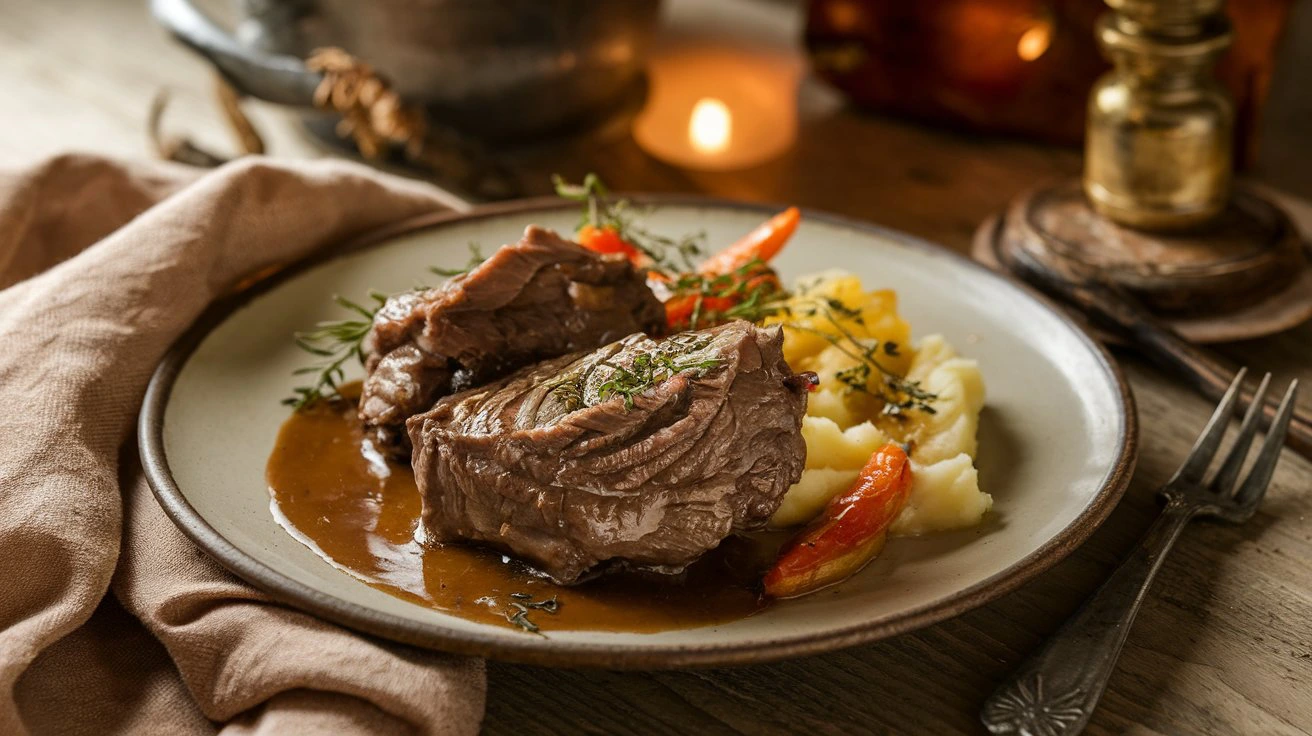When was the last time you indulged in a dish that felt like a warm hug on a chilly day? Beef cheek meat, with its rich, melt-in-your-mouth texture and deep, comforting flavor, is the ultimate ingredient to elevate your next cozy meal. Slow-cooked to perfection, this cut transforms into a tender, flavor-packed delight that pairs beautifully with hearty sides like mashed potatoes or polenta.
Whether you’re looking to impress at a family dinner or simply craving a satisfying, no-fuss recipe, beef cheek meat delivers every time. Let’s dive into how this hidden gem can bring bold, comforting flavors to your table!
Table of Contents
Key Benefits of Beef Cheek Meat
Beef cheek meat isn’t just a flavorful cut; it’s a culinary treasure waiting to be discovered. Here’s why it deserves a spot in your kitchen:

- Melt-in-Your-Mouth Tenderness
When slow-cooked, beef cheek meat transforms into a rich, buttery texture that’s simply irresistible. This makes it ideal for comfort food dishes like braised stews or slow-cooked curries. - Deep, Flavorful Goodness
Packed with robust, beefy flavor, this cut absorbs spices, herbs, and sauces beautifully. It’s perfect for dishes that rely on a slow cooking method to extract every bit of goodness. - Affordable and Versatile
Often more budget-friendly than prime cuts, beef cheek meat is a great choice for creating gourmet-style meals without breaking the bank. From rustic family dinners to elegant entertaining, its versatility shines. - Nutritional Benefits
Loaded with protein and collagen, beef cheek meat not only satisfies your taste buds but also contributes to a nourishing meal. It’s a wholesome ingredient for hearty, nutrient-rich recipes.
Whether you’re new to cooking with beef cheek meat or a seasoned pro, its unbeatable combination of flavor, texture, and value makes it a go-to choice for creating unforgettable meals. Ready to get started? Let’s gather the ingredients!
Ingredients You’ll Need
Gathering your ingredients ahead of time ensures a smooth and enjoyable cooking experience. Here’s what you’ll need to create a rich, flavorful beef cheek dish:
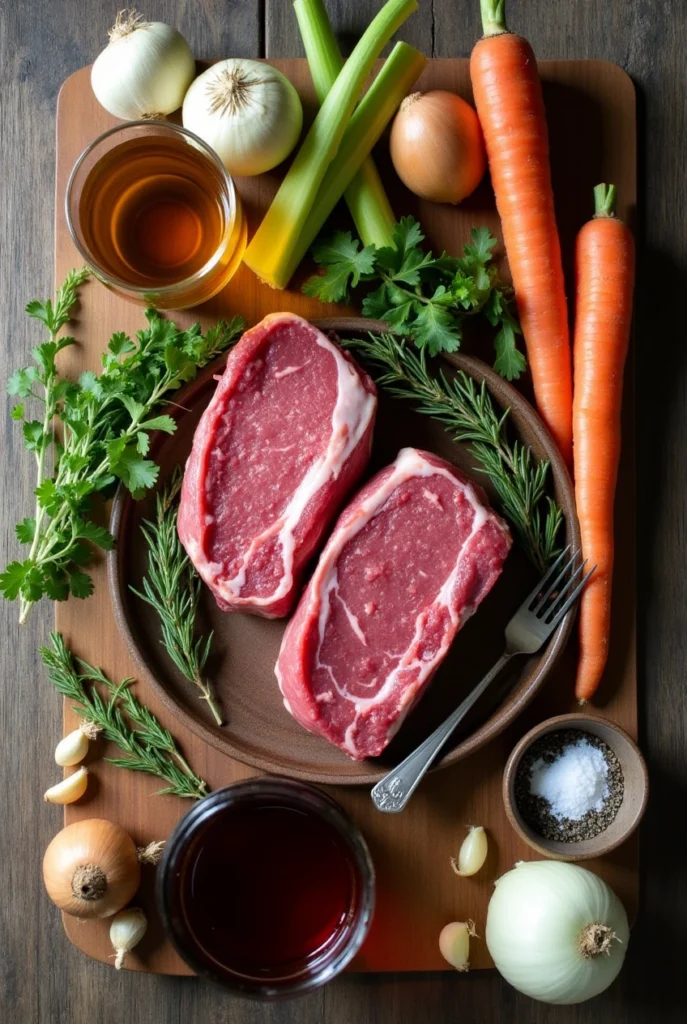
For the Beef Cheeks
- Beef cheek meat (2-3 pieces, approximately 1.5–2 pounds) – Look for cuts with good marbling to ensure tenderness.
- Salt and black pepper – To season and enhance the natural flavors.
- Olive oil (2–3 tablespoons) – For searing and adding a subtle depth of flavor.
Aromatics and Vegetables
- Onion (1 large, diced) – Adds sweetness and balance to the dish.
- Garlic cloves (4–5, minced) – Essential for building bold, savory flavors.
- Carrots (2 medium, chopped) – For a touch of natural sweetness and texture.
- Celery stalks (2, chopped) – Complements the aromatics and builds a rich base.
For the Sauce
- Red wine (1 cup) – Adds depth and enhances the savory notes (optional; substitute with beef broth if needed).
- Beef stock (2 cups) – The foundation for a hearty, flavorful sauce.
- Tomato paste (2 tablespoons) – Adds richness and a touch of acidity.
- Fresh herbs (thyme and rosemary, 2 sprigs each) – Infuse the dish with an earthy aroma.
- Bay leaf (1–2) – A subtle flavor enhancer that rounds out the sauce.
Optional Additions
- Mushrooms (1 cup, sliced) – For extra umami.
- Potatoes (cubed, added during cooking) – Makes it a one-pot meal.
Feel free to adjust these ingredients based on what you have on hand or your taste preferences. With everything prepped, you’re ready to move on to the fun part—cooking!
Step-by-Step Instructions
Now that you have your ingredients ready, let’s dive into making this delicious beef cheek dish. Follow these simple steps for a comforting and flavorful meal.
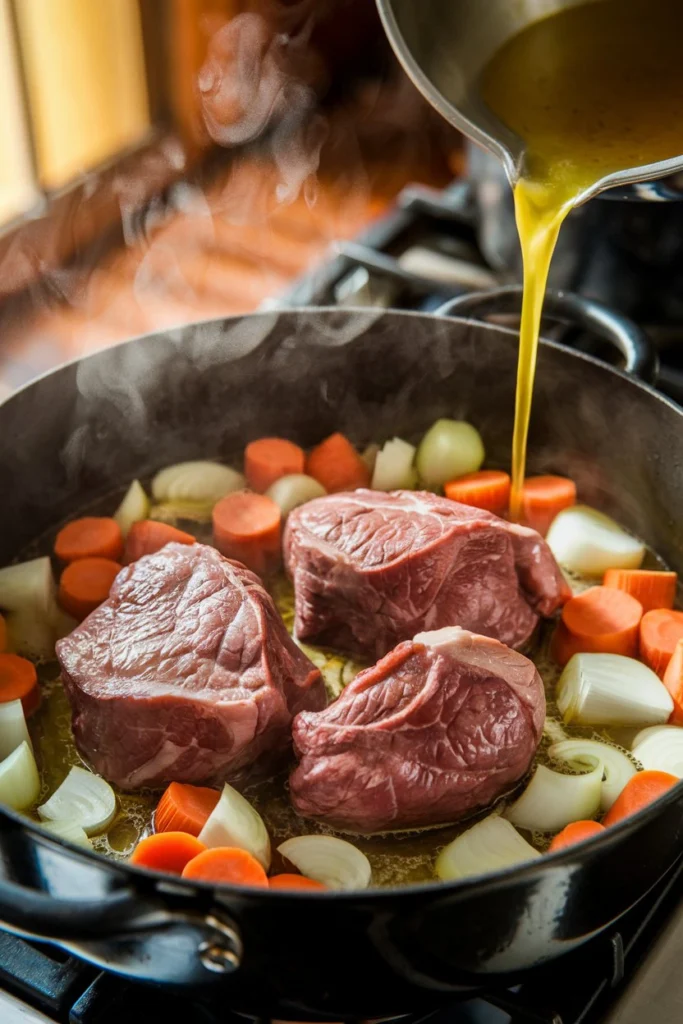
1. Prepare the Beef Cheeks
- First, pat the beef cheeks dry with paper towels to ensure they sear properly.
- Season generously with salt and black pepper on both sides to enhance the natural flavor of the meat.
2. Sear the Beef Cheeks
- Heat 2–3 tablespoons of olive oil in a large Dutch oven or heavy skillet over medium-high heat.
- Once the oil is hot, add the beef cheeks and sear them for 2–3 minutes on each side, or until a golden-brown crust forms. This step locks in the flavors, so don’t skip it!
- Once browned, remove the beef cheeks from the pan and set them aside on a plate.
3. Build the Flavor Base
- In the same pan, add the diced onion, minced garlic, chopped carrots, and celery. Sauté them for 5–7 minutes, stirring occasionally, until they soften and become fragrant.
- Stir in 2 tablespoons of tomato paste and let it cook for another 2 minutes. This step enhances the richness of the sauce and deepens the flavor.
4. Deglaze the Pan
- Pour in the red wine (or beef stock if you prefer a non-alcoholic option), scraping up any browned bits from the bottom of the pan with a wooden spoon.
- Let the wine simmer for 2–3 minutes to reduce slightly and intensify its flavor.
5. Combine and Simmer
- Return the seared beef cheeks to the pan, nestling them into the sauce.
- Add the beef stock, thyme, rosemary, and bay leaf, making sure the beef cheeks are mostly submerged in the liquid.
- Bring the mixture to a gentle boil, then reduce the heat to low. Cover the pan with a lid, and let it simmer for 3–4 hours, or until the beef cheeks are tender and fall apart easily when pierced with a fork.
- For a quicker option, you can use a slow cooker (set on low for 6–8 hours) or a pressure cooker (45–60 minutes on high pressure).
6. Finish the Sauce
- Once the beef cheeks are cooked to perfection, remove them from the pan and set them aside.
- For a thicker sauce, uncover the pot and let the sauce simmer for another 20–30 minutes, or mash some of the vegetables into the sauce for added texture.
- Taste the sauce and adjust the seasoning with salt and pepper if needed.
7. Serve and Enjoy
- Before serving, remove the thyme, rosemary sprigs, and bay leaf.
- Plate the beef cheeks and generously pour the sauce over the top. Pair with mashed potatoes, polenta, or your favorite sides for the ultimate comfort food experience.
By following these simple steps, you’ll create a dish that’s tender, flavorful, and absolutely irresistible. Enjoy!
Pro Tips and Variations
To elevate your beef cheek dish even further, here are some pro tips and variations that will make your recipe even more flavorful and versatile. Whether you’re looking for new ways to customize the dish or tips to make your cooking process smoother, these suggestions are sure to enhance your experience.
Pro Tips for Perfect Beef Cheeks
- Patience is key: The longer you cook beef cheek meat, the more tender and flavorful it becomes. If possible, allow it to slow-cook for 3–4 hours to reach that melt-in-your-mouth texture.
- Sear the beef cheeks well: Don’t rush the searing process! Ensure the beef cheeks develop a rich, brown crust by leaving them undisturbed for a few minutes on each side. This caramelization adds depth and richness to your dish.
- Low and slow cooking: Whether using a Dutch oven or slow cooker, keep the heat low to allow the beef cheeks to break down and absorb the flavors of the broth, herbs, and vegetables.
Flavor Enhancements and Variations
- Add a splash of balsamic vinegar: For a hint of tangy sweetness, add a tablespoon of balsamic vinegar during the deglazing step. It pairs beautifully with the rich flavor of the beef and balances out the richness of the sauce.
- Spices and herbs: While thyme and rosemary are classic, consider experimenting with other herbs like oregano or sage, or add a touch of smoked paprika for a unique twist.
- Vegetable options: You can easily swap in other vegetables like parsnips, turnips, or even sweet potatoes for a different flavor profile. These veggies will soak up the savory sauce beautifully.
- Add mushrooms: For a deeper umami flavor, sauté some mushrooms and stir them into the sauce during the last 30 minutes of cooking. They add both texture and an extra layer of savory goodness.
Quick Cooking Options
- Pressure Cooker: If you’re short on time but still craving the rich flavor of slow-cooked beef cheeks, a pressure cooker works wonders. Cook on high pressure for 45–60 minutes, and you’ll have a tender, flavorful dish in a fraction of the time.
- Slow Cooker: If you prefer hands-off cooking, a slow cooker can do the job just as well. Set it to low for 6–8 hours and let it work its magic.
Serving Variations
- Serve with polenta or mashed potatoes: These sides are perfect for soaking up the savory sauce and complement the tender beef perfectly.
- Make it a stew: Add more stock and vegetables, and you’ve got a hearty beef cheek stew that’s perfect for colder months.
These pro tips and variations give you the freedom to personalize your beef cheek dish and adapt it to your tastes. Have fun experimenting and enjoy the process of creating a dish that’s as unique as you are!
Serving Suggestions
Once your beef cheeks are tender and packed with flavor, it’s time to think about the perfect sides to accompany this hearty dish. Here are a few ideas that will take your meal to the next level and make every bite a comforting experience.
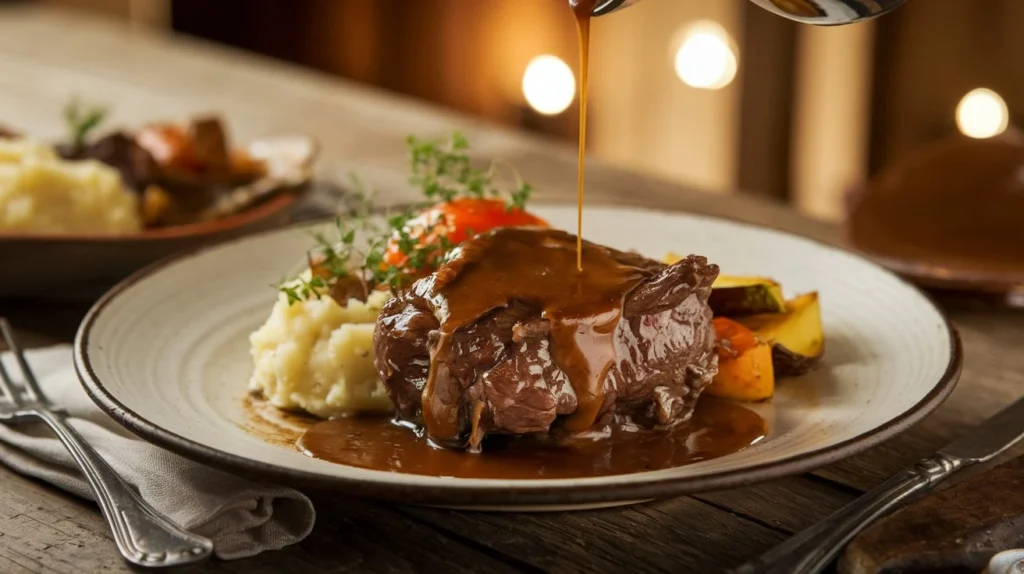
Classic Pairings
- Mashed Potatoes: A rich, creamy mash is the ultimate side to soak up all that savory sauce. Try adding a bit of garlic or butter to the potatoes for an extra flavor boost.
- Polenta: Soft, buttery polenta pairs beautifully with slow-cooked beef cheeks. It’s a cozy, comforting option that enhances the meat’s rich flavor and texture.
- Rice: If you want a lighter option, steamed rice works wonderfully, soaking up the flavorful broth from the beef cheeks. Consider adding a touch of fresh parsley or chives for a fresh contrast.
Hearty Veggies
- Roasted Vegetables: Think carrots, parsnips, or brussels sprouts tossed in olive oil, garlic, and herbs. Roasting them caramelizes the natural sugars, creating a wonderful contrast to the tender beef.
- Sautéed Greens: Lightly sautéed spinach, kale, or Swiss chard are a great way to add a fresh, slightly bitter flavor that complements the richness of the beef cheeks.
- Braised Cabbage: For a traditional touch, braised cabbage adds a nice balance of sweetness and acidity, cutting through the richness of the meat.
Bread and More
- Crusty Bread: You can never go wrong with some warm, crusty bread on the side. It’s perfect for mopping up the sauce and adds a comforting, rustic element to the meal.
- Garlic Bread: For a twist, serve garlic bread alongside your beef cheeks. The garlicky flavor pairs beautifully with the savory meat and adds a satisfying crunch.
Sauces and Garnishes
- Gravy: If you prefer a thicker, more concentrated sauce, use the drippings from the pan to make a rich gravy. It adds an extra layer of richness to the dish.
- Fresh Herbs: Garnish your beef cheeks with a sprinkle of fresh herbs like parsley, thyme, or rosemary. Not only does it add a pop of color, but it also enhances the overall flavor profile of the dish.
- Sour Cream or Horseradish: For a tangy kick, a dollop of sour cream or a bit of horseradish goes wonderfully with the beef cheeks, cutting through the richness with a little zest.
Each of these serving ideas will complement the flavors of the beef cheeks while offering variety and balance to your meal. Mix and match based on what you enjoy most, and watch as your family or guests rave about this comforting, full-bodied dish!
Conclusion
Beef cheek meat truly is the ultimate comfort food ingredient, offering both versatility and depth of flavor in every bite. Whether you’re preparing a hearty family dinner or impressing guests with a tender, melt-in-your-mouth dish, beef cheeks deliver an unforgettable experience. With the right technique, patience, and a few thoughtful ingredients, you can create a meal that is as satisfying as it is delicious.
Why You’ll Love This Recipe
- Tender, Flavorful Meat: Beef cheeks become incredibly tender after slow cooking, offering a rich, melt-in-your-mouth texture.
- Versatility: This dish can be paired with a variety of sides, making it a perfect option for any occasion.
- Comforting and Hearty: The deep, savory flavors and tender meat make this recipe the definition of comfort food.
Whether served with creamy mashed potatoes, roasted vegetables, or crusty bread, this beef cheek recipe will leave everyone at the table satisfied and asking for seconds. It’s a wonderful reminder that simple ingredients, when cooked with care, can create something truly extraordinary.
So, what are you waiting for? Grab those beef cheeks, get cooking, and enjoy the ultimate comfort food experience!
If you have any questions or need more tips on perfecting your beef cheek dish, don’t hesitate to reach out. Happy cooking!
______________________________
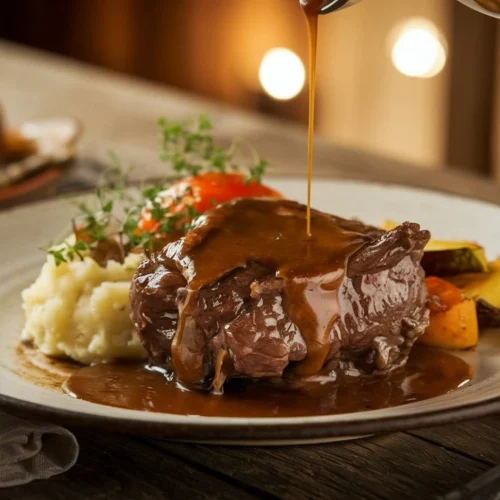
Beef Cheek Meat
Ingredients
For the Beef Cheeks
- Beef cheek meat 2-3 pieces, approximately 1.5–2 pounds – Look for cuts with good marbling to ensure tenderness.
- Salt and black pepper – To season and enhance the natural flavors.
- Olive oil 2–3 tablespoons – For searing and adding a subtle depth of flavor.
Aromatics and Vegetables
- Onion 1 large, diced – Adds sweetness and balance to the dish.
- Garlic cloves 4–5, minced – Essential for building bold, savory flavors.
- Carrots 2 medium, chopped – For a touch of natural sweetness and texture.
- Celery stalks 2, chopped – Complements the aromatics and builds a rich base.
For the Sauce
- Red wine 1 cup – Adds depth and enhances the savory notes (optional; substitute with beef broth if needed).
- Beef stock 2 cups – The foundation for a hearty, flavorful sauce.
- Tomato paste 2 tablespoons – Adds richness and a touch of acidity.
- Fresh herbs thyme and rosemary, 2 sprigs each – Infuse the dish with an earthy aroma.
- Bay leaf 1–2 – A subtle flavor enhancer that rounds out the sauce.
Optional Additions
- Mushrooms 1 cup, sliced – For extra umami.
- Potatoes cubed, added during cooking – Makes it a one-pot meal.
Instructions
Prepare the Beef Cheeks
- First, pat the beef cheeks dry with paper towels to ensure they sear properly.
- Season generously with salt and black pepper on both sides to enhance the natural flavor of the meat.
Sear the Beef Cheeks
- Heat 2–3 tablespoons of olive oil in a large Dutch oven or heavy skillet over medium-high heat.
- Once the oil is hot, add the beef cheeks and sear them for 2–3 minutes on each side, or until a golden-brown crust forms. This step locks in the flavors, so don’t skip it!
- Once browned, remove the beef cheeks from the pan and set them aside on a plate.
Build the Flavor Base
- In the same pan, add the diced onion, minced garlic, chopped carrots, and celery. Sauté them for 5–7 minutes, stirring occasionally, until they soften and become fragrant.
- Stir in 2 tablespoons of tomato paste and let it cook for another 2 minutes. This step enhances the richness of the sauce and deepens the flavor.
Deglaze the Pan
- Pour in the red wine (or beef stock if you prefer a non-alcoholic option), scraping up any browned bits from the bottom of the pan with a wooden spoon.
- Let the wine simmer for 2–3 minutes to reduce slightly and intensify its flavor.
Combine and Simmer
- Return the seared beef cheeks to the pan, nestling them into the sauce.
- Add the beef stock, thyme, rosemary, and bay leaf, making sure the beef cheeks are mostly submerged in the liquid.
- Bring the mixture to a gentle boil, then reduce the heat to low. Cover the pan with a lid, and let it simmer for 3–4 hours, or until the beef cheeks are tender and fall apart easily when pierced with a fork.
- For a quicker option, you can use a slow cooker (set on low for 6–8 hours) or a pressure cooker (45–60 minutes on high pressure).
Finish the Sauce
- Once the beef cheeks are cooked to perfection, remove them from the pan and set them aside.
- For a thicker sauce, uncover the pot and let the sauce simmer for another 20–30 minutes, or mash some of the vegetables into the sauce for added texture.
- Taste the sauce and adjust the seasoning with salt and pepper if needed.
Serve and Enjoy
- Before serving, remove the thyme, rosemary sprigs, and bay leaf.
- Plate the beef cheeks and generously pour the sauce over the top. Pair with mashed potatoes, polenta, or your favorite sides for the ultimate comfort food experience.
- By following these simple steps, you’ll create a dish that’s tender, flavorful, and absolutely irresistible. Enjoy!
Notes
- Calories: 450–500 kcal
- Fat: 25–30 g
- Saturated Fat: 10–12 g
- Cholesterol: 85–95 mg
- Sodium: 400–500 mg
- Carbohydrates: 8–12 g
- Fiber: 2–3 g
- Sugar: 2–4 g
- Protein: 45–50 g
- Iron: 3–4 mg
FAQs
To help you create the best beef cheek dish possible, here are some answers to commonly asked questions that will guide you through the process and ensure your cooking experience is smooth and enjoyable.
1. How do I know when the beef cheeks are done cooking?
The beef cheeks are done when they are fork-tender, meaning they should easily shred with a fork. Depending on your cooking method:
Slow Cooker: 6–8 hours on low heat.
Stovetop/Oven: 3–4 hours on low heat.
Pressure Cooker: 45–60 minutes on high pressure. If you’re unsure, you can always check the meat for tenderness by gently pulling it apart with a fork.
2. Can I use beef cheek meat for other recipes?
Absolutely! Beef cheeks are incredibly versatile. Their tender, flavorful nature makes them perfect for tacos, sandwiches, stews, or even soups. They add depth and richness to any dish that benefits from slow-cooked meat. Adjust the seasoning based on the dish you’re preparing for a delicious variation every time.
3. How should I store leftover beef cheeks?
To store leftovers, let the dish cool completely, then transfer the beef cheeks to an airtight container. They will stay fresh in the fridge for 3–4 days. If you want to store them longer, beef cheeks freeze beautifully! Place them in a sealed container or freezer bag, and they will last up to 3 months. When you’re ready to eat, simply thaw overnight in the fridge and reheat on the stove or in the oven.
4. Can I make beef cheeks ahead of time?
Yes! In fact, beef cheeks often taste even better the next day as the flavors have more time to meld together. You can prepare the dish ahead of time, refrigerate it for up to 2 days, and reheat it gently when ready to serve. This makes it an excellent option for meal prepping or hosting a dinner party.
5. What other cuts of beef can I use if I can’t find beef cheeks?
If beef cheeks aren’t available, you can substitute with other cuts like short ribs, chuck roast, or brisket. These cuts also become incredibly tender when slow-cooked, though they may require slightly different cooking times. The result will still be a rich, flavorful dish.
6. What should I serve with beef cheeks?
Beef cheeks pair wonderfully with a variety of sides:
Mashed Potatoes: A classic side that soaks up the rich sauce beautifully.
Polenta: Creamy polenta is another great choice to complement the beef’s texture.
Roasted Vegetables: Roasted carrots, parsnips, and brussels sprouts are perfect additions.
Rice: A simple serving of rice can absorb all the delicious broth from the beef cheeks.
Feel free to get creative with your sides—whatever suits your taste and adds variety to your meal.
7. Can I add vegetables to the pot while cooking the beef cheeks?
Definitely! Adding vegetables like carrots, celery, and onions enhances the flavor of the dish. Root vegetables, such as parsnips or turnips, also absorb the savory sauce, making them a perfect addition. Simply add them to the pot at the start of cooking for a well-rounded, hearty meal.
If you have more questions or need any help with your recipe, don’t hesitate to reach out. Enjoy the process, and happy cooking!

